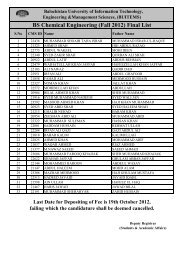BUITEMS
Research Journal - buitems
Research Journal - buitems
- No tags were found...
You also want an ePaper? Increase the reach of your titles
YUMPU automatically turns print PDFs into web optimized ePapers that Google loves.
<strong>BUITEMS</strong><br />
Quality & Excellence in Education<br />
Orange peel as an adsorbent for the removal of reactive blue dye from textile wastewater.<br />
adsorption of 91.7% and 84.4% of adsorption<br />
were obtained at 25 and 50 mg/L respectively.<br />
Effect of adsorbent dose<br />
From experimental results it was found that<br />
the increase of adsorbent dose from 10-50<br />
g/L increased the adsorption at optimized pH<br />
levels of 8.0 –9.0, with mesh size of 600 um<br />
and 1200 um respectively, at the shaking<br />
speed of 160 rpm and contact time of 55<br />
minutes. Furthermore it was found that the<br />
maximum adsorption capacity was 84.6%-<br />
92.2% at 40g/Liter and 50 g/L of adsorbent<br />
dose with 600 um and 1200 um mesh sizes<br />
at initial dye concentration of 25mg/L.<br />
Effect of particle size<br />
The particle size also plays a major role in<br />
adsorption due to the surface of the<br />
adsorbent material, higher the surface area<br />
higher the adsorption, lower the surface area<br />
lower the adsorption. Particle sizes were<br />
varied from (600-1200 um) and (3.0-5.0 Mesh<br />
sizes) microns. For different particle sizes,<br />
the removal percentages of dye on orange<br />
peel were measured; the values are given<br />
Table.2 Shows the results for maximum color<br />
removal of dyes at different particle sizes.<br />
Table: 4 Shows the effect of particle size on<br />
percentage of dye removal<br />
Table: 3 Shows the effect of adsorbent dose on<br />
percentage of dye removal<br />
Figure:: 2 Shows the percentage of dye removal at<br />
different doses<br />
Figure: 3 Shows the percentage of dye removal on<br />
different particle sizes<br />
Maximum color removal was obtained at 25<br />
mg/L of dye concentration; the 60% color was<br />
removed at 10g/L as initial adsorbent dose<br />
and removal percentage was increased as<br />
dose increased up to 50 g/L on which color<br />
removal was found to be 90-92%. It is clear<br />
from the above results that the increase in<br />
adsorbent dose increased the adsorption and<br />
decrease in color removal when adsorbent<br />
dose eas reduced.<br />
The results clearly showed that the maximum<br />
adsorption was obtained at a concentration<br />
of 25 mg/L with particle size of 600 um and<br />
1200 um. As the concentration of dye<br />
increased in the adsorption of dye on the<br />
orange peel decreased and when the dye<br />
concentration was reduced to 25mg/L, the<br />
maximum color removal 82-88% was<br />
obtained.<br />
Increase in particle size gave the lower<br />
adsorption due to the low surface area and<br />
decrease in particle size gave the higher<br />
adsorption due to the more surface area. It<br />
was concluded from the observation that the<br />
51
















